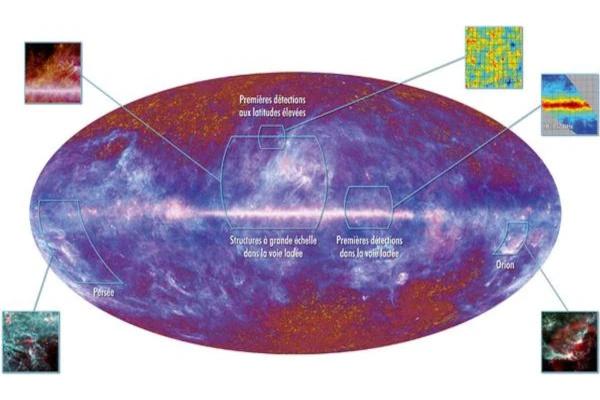
The cosmic microwave background (CMB) is the residual electromagnetic radiation emitted about 380,000 years after the Big Bang. At that time, the Universe had cooled sufficiently to allow the formation of the first hydrogen atoms, making the cosmos transparent to light. This radiation, which then filled all space, was stretched by the expansion of the Universe to centimeter wavelengths, corresponding today to an average temperature of \(2.725\ \text{K}\).
Measurements from the COBE satellite (1989), then WMAP (2001-2010) and Planck (2009-2013), have shown that the CMB spectrum remarkably follows the blackbody radiation law.
This spectral distribution indicates that the cosmic microwave background is thermal radiation in equilibrium, emitted by a plasma of photons, electrons, and protons once in constant interaction.
N.B.:
A blackbody is a perfect physical system that fully absorbs all incident energy and re-emits radiation depending only on its temperature. Its spectrum is described by Planck's law, which relates spectral energy density to frequency \(\nu\) and temperature \(T\) as: \(\displaystyle B(\nu, T) = \frac{2h\nu^3}{c^2}\frac{1}{e^{h\nu/kT} - 1}\). The cosmic microwave background is the best-known natural example of blackbody radiation, with a deviation of less than \(10^{-5}\) from theory.
Despite its remarkable homogeneity, the CMB exhibits small anisotropies (temperature fluctuations on the order of \(10^{-5}\)). These inhomogeneities are the imprints of primordial quantum fluctuations amplified by cosmic expansion. They served as seeds for the later formation of large-scale structures in the Universe.
The WMAP and Planck missions mapped these anisotropies with unprecedented precision, providing essential constraints on cosmological parameters such as the Hubble constant \(H_0\), matter density \(\Omega_m\), and dark energy density \(\Omega_\Lambda\).
The polarization of the cosmic microwave background provides additional information about the physical processes that occurred before recombination. In particular, the detection of a B-mode polarization pattern could reveal the presence of primordial gravitational waves, predicted by the theory of cosmic inflation formulated by Alan Guth (born 1947).
These gravitational waves would have left a subtle signature in the texture of the fossil radiation, offering an indirect test of the first \(10^{-35}\ \text{s}\) of cosmic history.
The cosmic microwave background is not just a relic of the past; it is also a window into fundamental physics. The smallest deviations measured in its spectrum and polarization test models of the FLRW Universe and the predictions of Albert Einstein's (1879-1955) general relativity.
Analysis of the CMB has confirmed that our Universe is spatially flat to better than 0.4%, and that visible matter makes up only about 5% of the total energy content, with the rest shared between dark matter and dark energy.
N.B.:
The cosmic microwave background is not observable in the visible domain because its radiation, initially in the infrared, has been stretched by the expansion factor \((1 + z) \approx 1100\), placing its spectral peak today at about \(160\ \text{GHz}\).
| Mission | Period | Agency | Major Result |
|---|---|---|---|
| COBE | 1989-1993 | NASA | Confirmation of the blackbody spectrum and first detected anisotropies |
| WMAP | 2001-2010 | NASA | Detailed mapping of anisotropies and refinement of cosmological parameters |
| Planck | 2009-2013 | ESA | Measurement of the average temperature \(T = 2.7255\ \text{K}\) and the flatness of the Universe |
Source: WMAP Science Team, ESA Planck Legacy Archive.